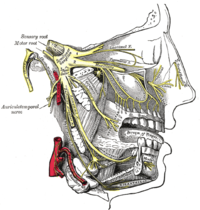
Photo from wikipedia
Purpose To determine optimal management strategies for the treatment of mandibular AVM. Materials and Methods 16 patients (12 females, 4 males), age 9–14; mean age 12, underwent endovascular therapy to… Click to show full abstract
Purpose To determine optimal management strategies for the treatment of mandibular AVM. Materials and Methods 16 patients (12 females, 4 males), age 9–14; mean age 12, underwent endovascular therapy to treat their mandibular AVMs. 12 patients had distinct intraosseous AVMs. 4 had multiple additional facial and intra-maxillary AVMs requiring treatment. Outside institutions recommended massive hemi-facial resections in these patients. Four patients had prior PVA and gel foam embolization, one patient had a lip graft, one had prior mandible surgery. All treatments that had failed Results All 16 patients have demonstrated MR and angiographic cure of their AVMs. One patient’s therapy is not completed and is on-going. The patient’s mandibular AVM is cured, a third AVM in this patient in the right maxilla is still undergoing treatment. The follow-up range is 11 months - 41 months, with a mean follow-up of 29 months. No complications were noted in treatment of mandibular AVMS. One patient required a minor gingival surgery after treatment of an additional intramaxillary AVM. Conclusions Endovascular approaches to manage mandibular AVM can be curative. The intraosseous variety is largely a fistula between artery and vein within the bone. All respond well to endovascular ethanol therapy alone. Surgery was not required in any patient. Surprisingly no complications were encountered in this patient series. Long-term cures are noted in this patient series with endovascular approaches alone. No massive surgical resections in any patient, even in patients with multiple AVMs of the soft tissues, mandible and maxilla, was required to effect cure. In patients who suffered hemorrhages from floating teeth, bone formed and stabilized the teeth and no further hemorrhages occurred. Ethanol sclerotherapy proved curative in mandibular intraosseous AVMs in patients who had additional facial soft-tissue AVMs gingival AVMs and intramaxillary AVMs that were cured as well at long-term follow-up. Disclosures W. Yakes: None.
Journal Title: Journal of NeuroInterventional Surgery
Year Published: 2017
Link to full text (if available)
Share on Social Media: Sign Up to like & get
recommendations!